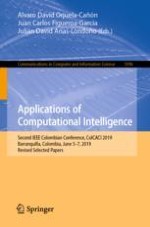2019 | Buch
Applications of Computational Intelligence
Second IEEE Colombian Conference, ColCACI 2019, Barranquilla, Colombia, June 5-7, 2019, Revised Selected Papers
herausgegeben von: Alvaro David Orjuela-Cañón, Juan Carlos Figueroa-García, Julián David Arias-Londoño
Verlag: Springer International Publishing
Buchreihe : Communications in Computer and Information Science
